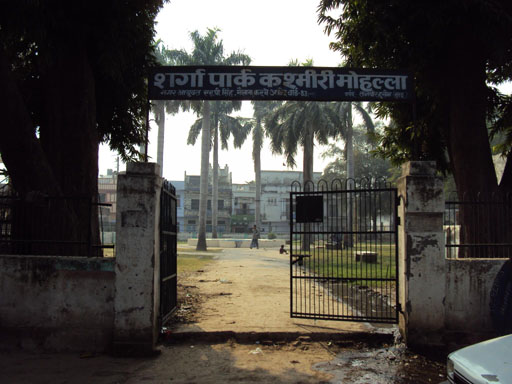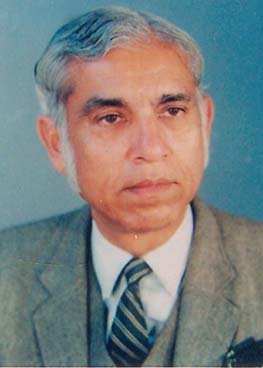Sharga Park
A Mute Witness of our Freedom Struggle
By Dr. B.N. Sharga
The Sharga family occupies an
important place in the history of Oudh. Shargas are the royal “Wasiqedars”.
They belong to a Marshal race and their ancestors were brave fighters. They
trace their origin from Mongolia, where a province, a river and a tribe exists
by that name. In Mongolian Dialect the word “shargas” is used for
a horse. Their ancestors were idol worshippers and came to Kashmir from Mongolia
during the reign of the Emperor Kanishk via Asian-Silk Route and after settling
down in Rainawari locality of the Srinagar district they adopted local
Brahmanical order as their way of life.

Shargas ancestor Pandit Narayan
Kaul(1640-1712) was a famous historian of Kashmir. His son Zind Ram Kaul came to
Delhi from Kashmir during the reign of Mughal Emperor Aurangzeb and got an
employment in the Mughal Army. He became a Commander of its Mounted Regiment in
the Lashkar of Moit-Ma-ud-Daula.
Zind Ram Kaul’s son Sahib Ram
Kaul like his father also became a Commander of a Cavalry in the Mughal Army.
When “Naib
Wazir” Shuja-ud-Daula became the “Subedar”
of Oudh in 1754 he brought Sahib Ram Kaul’s sons Laxmi Narayan Kaul Sharga and
Nianjan Das Kaul Sharga from Delhi to Faizabad and made them Commanders of his
elite Royal Mounted Guards responsible for the security of his main Palace. Both
these brothers fought very gallantly against the British in the battle of Buxar
in 1764 and saved the life of “Naib Wazir” Shuja-ud-Daula for which his Principal wife
Bahu Begum granted them a “Wasiqa”
a sort of hereditary pension of 200 Silver coins per month besides a Royal “Khilat” alongwith
some “Jagirs”
in the Farrukhabad district. When “Naib
Wazir” Asaf-ud-Daula became the “Subedar”
of Oudh in 1775 he shifted his seat of Government from Faizabad to
Lucknow. Consequently both Laxmi Narayan Kaul Sharga and Niranjan Das Kaul
Sharga came to Lucknow and started living in Kashmiri Mohalla. Durga Prasad
Sharga who was the son of Laxmi Narayan Kaul Sharga was an erudite Persian
scholar and a tutor of King Wajid Ali Shah besides being an advisor of his
mother Malka Kishwar and so he used to command a great respect in the Oudh
court. When in June 1856 Malka Kishwar went to London with a 110 member
delegation to meet Queen Victoria and to submit a memorandum against the
dethroning of the King Wajid-Ali-Shah, Durga Prasad Sharga accompanied the
former on this mission due to which the British stopped the payment of Wasiqa to
Durga Prasad Sharga and confiscated his Jagirs as a punishment. His grandson
Baij Nath Sharga(1850-1890) had to seek an employment outside Oudh in the Jaipur
court and became a “Hakim” of Ganga Nagar
district of that Princely Estate.
In 1884 Bishen Narayan Dar
(1864-1916) went to England to study law against the wishes of the community
members as sea-voyage was considered to be an unpardonable sin in that era due
to which a sharp division in the community took place into “Dharam Sabha” and “Bishen
Sabha”. A year later in 1885 a British ICS officer Sir Alexander
Octavian Hume formed the Indian National Congress to fight for the
constitutional rights of the citizens of the country.
Bishen Narayan Dar came back to
Lucknow from London in 1887 as a young barrister. He was a great crusader and a
champion of human liberty. He joined the Congress Party and started giving the
electrifying political speeches. He was a great orator and so he became very
soon a popular political leader of the masses. He sparked the freedom struggle
and became its founding father. He was considered to be the most learned
politicians of that era next to Rais Behari Ghosh.
He was the only person from
Lucknow till date to become the President of the Indian National Congress in its
27th plenary session held in Calcutta in 1911. He became an
honourable member of the Imperial Legislative Council in 1914. Due to his
personal influence and stature many progressive minded Kashmiri Pandits living
in Kashmiri Mohalla at that time became an active worker of the Congress Party.
Rai Bahadur Pandit Shyam Manohar
Nath Sharga(1879-1952) who was a son of Baij Nath Sharga became a District and
Sessions Judge during the British period. He was a great philanthropist,
educationist and ardent lover of nature. Due to his zeal and untiring efforts
Sharga Park came into existence in Kashmiri Mohalla around 1908 for which he
donated land and a big amount of money to the then Lucknow Municipal Board whose
Executive Officer was his close friend Pandit Maharaj Narayan Chakbast. He used
to take a very keen personal interest in the proper upkeep and maintenance of
this park. Sharga Park due to its ideal location in a densely populated area
soon became a nerve centre of social and political activities of the local
residents. Many stalwarts of our Freedom Struggle like Bal Gangadhar Tilak,
Gopal Krishana Gokhale, Dr. Annie Besant, Pandit MotiLal Nehru, Pandit Madan
Mohan Malviya, Dr Sir Tej Bahadur Sapru, Pandit Brij Narayan Chakbast, Pandit
Brij Nath Sharga, Mrs.Dharajpati Bakshi, Dr. Hriday Nath Kunzru, Dr. Madan Atal,
Pandit Jagat Narayan Mulla addressed their political meetings in Sharga Park as
Jhandewalan Park in Aminabad was developed much later.
There was a time when this
historic Sharga Park closely connected with our freedom struggle used to be the
most beautiful and very well maintained park of the old city. It used to bag the
first prize in the annual Flower Show competition being organized by the Garden
department of the Lucknow Municipal Corporation. Unfortunately the bad days for
this important landmark of our freedom struggle started just after the Indo-Pak
war of 1965, when some misguided and mentally bankrupt officials of the Lucknow
Municipal Corporation ordered the construction of a gigantic concrete overhead
water tank in it after chopping off its lofty Ashoka trees on the land which
actually belongs to the Sharga family much against the wishes of the local
residents. This unwise step of the Municipal authorities not only destroyed the
basic character of this historic Sharga Park but also encouraged undesirable
elements to grab its precious land. Since then a number of illegal structures
have come up on its land in total violation of the Municipal Rules and
Regulations and in total contravention of the guidelines given by the honourable
Supreme Court of India in this regard under the Gardens, Parks and Open
Playgrounds Act of 1975. Now this park has no trees, no flower beds and not even
a blade of grass. It has become a den of anti-social elements and “shohdas”.
No respectable person likes to visit this park anymore.
The State Government has now
decided to restore the old beauty and grandeur of Daya Nidhan Park in Lal Bagh
which was developed in 1914 in memory of Pandit Daya Nidhan Ganjoo by his
grandson Pandit Jagpal Kishen Ganjoo. It is hoped that the State Government
likewise would take effective steps to restore the basic character of the Sharga
Park in Kashmiri Mohalla which is a symbol of Lucknow’s glorious historical
past and its rich cultural heritage. The State Tourism Development has recently
introduced a Heritage Walk in the old city to make its citizens familiar with
it’s past history and it’s heritage. The historic Sharga Park should also be
included in this Heritage Walk and should be declared as a protected site
because it is more than 100 years old and is closely connected with our freedom
struggle. Zee Tv(Uttarakahnd & UP) has made a documentary on Kashmiri
Mohalla directed by Nikhil Kumar highlighting the historical importance of
Sharga Park which was televised on it’s network on 5th and 6th
of August,2010 under its ‘Mati ki Mehak’ programme.
| 













